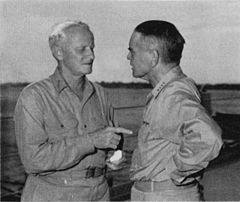The Secret Formula for Leadership?
There are hundreds of books written on leadership every year, most of which claim to analyze and isolate the traits that make someone a good leader, as if there is a secret formula for leadership that can be bottled and sold. The fact that each book’s secret formula is different does not seem to deter the writers or their readers.
There is no secret formula or combination of traits that will make anyone the best leader, and an excellent illustration of this can be found in Walter Borneman’s new book, The Admirals, which chronicles the careers of the four American admirals who achieved five-star rank while leading our nation to victory in WWII.
The highest ranking (by design, he was the first promoted to the new five-star rank, so that he would have seniority), most influential, and least heralded was William Leahy, who served during the war as FDR’s personal military adviser. FDR came to rely on him so much that he effectively served as his chief of staff, Chairman of the Joint Chiefs, and national security adviser. Leahy was strong-willed and opinionated; he always spoke the truth to the President even when he disagreed, yet he backed his boss’s decisions to the hilt, so much so that Truman kept him on the job for four more years. The fact that he was so unpublicized speaks to his willingness to put his own needs aside for the good of his boss and the country, and his ability to work quietly behind the scenes to get things done.
Ernest King was anything but quiet. He was bombastic, overbearing, and extremely intolerant of anyone who did not meet his exacting standards. (Kind of like a 1940s version of Steve Jobs). He got the best out of people by scaring the hell out of them, but he respected those who stood up to him when he was wrong. He was reported to have said, “When they get into trouble, they always send for the sons of bitches.”
That was a nice quote, but Chester Nimitz proved it wasn’t always true. Of the four, he was probably the best loved by his subordinates. He was the epitome of the wise grandfather, steady, supportive, and wise. He had spent the later stages of his career before the war in the Navy’s version of a personnel department, and was a keen judge of talent. He said, “Leadership consists of picking good men and helping them do their best for you.” When he arrived to take command of the Pacific Fleet in still-smoldering Pearl Harbor, he retained most of the existing staff, and rebuilt their confidence and fighting spirit.
Probably the best known was Bill Halsey, partly because his personality was such that he craved the limelight. He was blustery, aggressive and impulsive. In fact, the Japanese took advantage of his aggressiveness and impetuosity by purposely luring him away from his position protecting the Philippine invasion forces. Never a careful planner, he seemed to make things up as he went along, but his aggressiveness and style made him a hero to his sailors and marines. One time two young enlisted men were walking down a corridor and one said, “I’d go to hell for that old son of a bitch.” He felt a poke in his back and saw Admiral Halsey, who, said, “Not so old, young man.”
It would be hard to find a leadership team that was so diverse but functioned so well together. Four men who were so different, yet each made a huge contribution during one of the most fateful times in our nation’s history. Probably as importantly, this team of four strong-willed and totally different individuals stayed together and worked together for the entire war. Was there in fact a secret formula that each shared, beneath the superficial differences in style?
Roland Smoot, a naval historian and himself a retired admiral, said: “Each had the ability to make men admire them in one way or another.” They did it through a “commanding presence that engendered commitment and resolve toward a common purpose.”
Smoot said Leahy did it by submerging his own personal feelings to the best interests of the country; King did it through bluster and verve; Nimitz would put his hand on your shoulder and say “let’s get this thing done”; Halsey would rush to the line in such a way that others wanted to follow.
Yet, if there is in fact a secret formula for leadership, I believe it’s encapsulated in those seven words: “commitment and resolve toward a common purpose.” With that approach and that attitude, any leadership style can work; without it, any leadership style can fail.





Thanks for this article, Jack – very good food for thought!
I had two responses to the article as I was reading it:
1. When defining “good leadership,” it may be best to back up and first define what good leadership produces. Does it produce a quick response from “followers”? Does it reduce the probability that there will be the need for fighting/wars? It seems to me that most who try to identify components of great leadership put the cart before the horse by failing to first clarify what great leadership produces.
2. Most of my favorite “leaders” are those who lead people back to themselves and have no desire for followers. I think it might have been Plato who said that anyone who puts themselves up for a leadership role should be immediately disqualified for that role – and Dr. Carl Rogers believed that “followers” of his often caused him more distress than his critics. Interesting stuff to consider, I think!